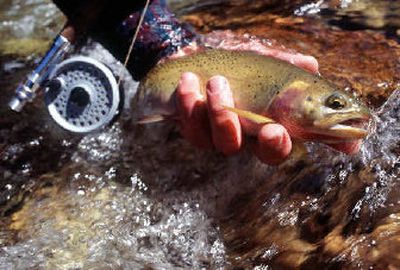Anglers back North Idaho trout release

Catch-and-release rules in North Idaho’s premier native cutthroat trout streams received a vote of confidence from anglers in public meetings and surveys conducted this spring.
Jim Fredericks, Idaho Fish and Game Department regional fisheries manager, launched the public comment process before drawing up this year’s round of fishing rule proposals.
Fredericks said the agency had received significant pressure to allow some harvest of cutthroat trout after several years of catch-and-release rules had improved the size and numbers of the native species in the St. Joe and Coeur d’Alene drainages.
A majority of the anglers surveyed favor the results in the fishery. They said they would prefer to maintain catch-and-release rules to avoid a decline in the size and numbers of cutthroats.
More than 145 people attended public meetings around the Panhandle, about 75 anglers provided e-mail or telephone input and more than 800 individuals completed the web-based survey, Fredericks said.
Also, nearly 500 anglers who bought licenses in the Panhandle Region were included in a random survey.
The agency will propose no changes to catch-and-release rules this year, he said.
To curb confusion regarding the identification of rainbow-cutthroat hybrids and minimize the number of cutthroat trout misidentified and harvested as hybrids, the agency is proposing this rule for the St. Joe and Coeur d’Alene river systems: “no harvest of any trout with a red or orange slash under the jaw.”
Anglers were more divided on proposals for managing mackinaw, kokanee and cutthroat trout around Priest Lake.
“It should be very clear to all who participated in this process that there is no simple answer to the question, ‘What do anglers want?’ ” Fredericks said.
The agency is trying to decide whether to abandon efforts to maintain the native bull trout and cutthroat fisheries in Upper Priest Lake or launch a large-scale effort to reduce the number of lake trout in Priest Lake.
“Overall, respondents were fairly evenly split on the alternatives,” Fredericks said.
He said biologists will use the next five years to study the lakes, including the kokanee fishery, for more data before making proposals.
No changes in lake trout rules will be proposed this year, but Fredericks will propose lowering the kokanee limit from 15 to six.
On Lake Pend Oreille issues, anglers gave strong support for shifting to trophy rainbow trout management with restrictive limits and harvest closures during spawning season, Fredericks said.
Biologists tentatively believe the kokanee fishery has recovered enough to be reopened – for the first time since 1999 – with a six-fish daily limit.
“We will have one more opportunity to conduct kokanee population estimates before making final proposals to the commission. If we see the kokanee recovery has faltered, and we’re not as confident the population can support harvest, we will withdraw that proposal,” Fredericks said.
The Fish and Game Commission votes on fishing proposals in November.
To begin rebuilding the trophy rainbow fishery, the agency also will propose reducing the rainbow trout limit to six, with only one fish over 20 inches.
In addition, more protection would be proposed for rainbows in the Clark Fork and other lake tributaries.